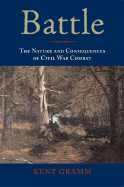 Battle: The Nature and Consequences of Civil War Combat by Kent Gramm; 147 pages; University of Alabama Press (April 2008); ISBN-13: 978-0817354824
Battle: The Nature and Consequences of Civil War Combat by Kent Gramm; 147 pages; University of Alabama Press (April 2008); ISBN-13: 978-0817354824
The essays in “Battle” do a fine job presenting the conditions on the battlefield that the average soldier faced. Without attempting to interpret what the experience might have accomplished within the psychology of a soldier, instead the writers attempt to take the reader down to ground level.
In addition to an introduction, an afterword, and an essay on the “Numbers” by editor Gramm, Paul Fussell contributes a powerful essay on “The Culture of War”; D. Scott Hartwig examines the face of battle at Gettysburg; Bruce A. Evans discusses “Wounds, Death, and Medical Care in the Civil War”; Eric T. Dean rethinks the meaning and consequences of combat in “The Awful Shock and Rage of Battle”; and Alan T. Nolan looks at the national consequences of battle and the resultant myth of the Lost Cause
Combat was often a close quarter affair during the Civil War, with the average range of engagement around 140 yards. At Gettysburg it was even closer, with a 100 yard average.
After the fighting was just as horrific and Bruce A. Evans has a good essay on the conditions and nature of surviving a fight, which was not always a good thing if severely wounded.
Overall, a solid book that delivers on its promise.